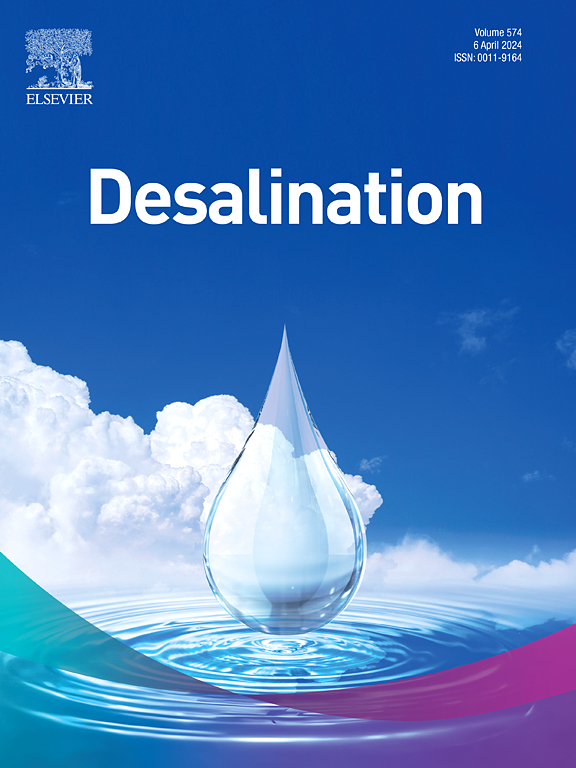全天候收集淡水的辐射冷却辅助界面蒸发建模与性能评估
IF 8.3
1区 工程技术
Q1 ENGINEERING, CHEMICAL
引用次数: 0
摘要
淡水资源短缺是急需解决的主要挑战之一。太阳能界面蒸发技术也面临着蒸汽的有效冷凝回收和无法在夜间蒸发等问题。在这项工作中,通过耦合太阳能界面蒸发和辐射冷却技术,设计了一种全天候蒸发-淡水收集装置。该系统利用被动辐射冷却加速水蒸气凝结,同时满足淡水夜间凝结收集,提高淡水收集效率。首先对该装置的淡水收集性能进行了实验测试。实验结果表明,该装置一天可收集淡水 3.27 kg m-2,白天和夜间的平均收集率分别达到 0.24 kg m-2 h-1 和 0.074 kg m-2 h-1。此外,还根据传热传质和能量转换理论构建了全天候系统蒸发冷凝淡水收集数值模型,并利用实验结果验证了数值模型的准确性。利用典型气象年的环境数据,通过验证后的模型研究了蒸发收集装置在中国各地收集淡水的潜力,并分析了不同地区的可再生能源。最后,讨论了相对湿度、云量和对流传热系数对系统收集淡水的影响,这项工作为蒸发收集装置未来如何实现广泛部署提供了重要启示。本文章由计算机程序翻译,如有差异,请以英文原文为准。
Modeling and performance evaluation of radiative cooling-assisted interfacial evaporation for all-day freshwater harvesting
The shortage of freshwater resources is one of the major challenges that need to be addressed urgently. Solar-powered interfacial evaporation technologies also face problems such as efficient condensation recovery of vapors and inability to evaporate at night. In this work, an all-day evaporation-freshwater harvesting device is designed by coupling solar interfacial evaporation and radiative cooling technologies. The system utilizes passive radiative cooling to accelerate water vapor condensation and, at the same time, meets the nighttime condensation collection of freshwater to improve the efficiency of freshwater collection. The freshwater collection performance of the device was first tested experimentally. According to the experimental results, the device can collect 3.27 kg m−2 of freshwater in a day, and the average collection rates during daytime and nighttime reached 0.24 kg m−2 h−1 and 0.074 kg m−2 h−1, respectively. In addition, a numerical model of systematic all-day evaporation and condensation with freshwater collection was constructed based on the theory of heat and mass transfer and energy conversion, and the accuracy of the numerical model was verified using experimental results. The potential of the evaporation collection device to collect freshwater across China was studied by the verified model using environmental data from typical meteorological years, and analyzed the renewable energy in different regions. Finally, the effects of relative humidity, cloudiness, and convective heat transfer coefficients on the collection of freshwater in the system are discussed, and this work provides important insights into how evaporative collection devices can achieve widespread deployment in the future.
求助全文
通过发布文献求助,成功后即可免费获取论文全文。
去求助
来源期刊

Desalination
工程技术-工程:化工
CiteScore
14.60
自引率
20.20%
发文量
619
审稿时长
41 days
期刊介绍:
Desalination is a scholarly journal that focuses on the field of desalination materials, processes, and associated technologies. It encompasses a wide range of disciplines and aims to publish exceptional papers in this area.
The journal invites submissions that explicitly revolve around water desalting and its applications to various sources such as seawater, groundwater, and wastewater. It particularly encourages research on diverse desalination methods including thermal, membrane, sorption, and hybrid processes.
By providing a platform for innovative studies, Desalination aims to advance the understanding and development of desalination technologies, promoting sustainable solutions for water scarcity challenges.
 求助内容:
求助内容: 应助结果提醒方式:
应助结果提醒方式:


